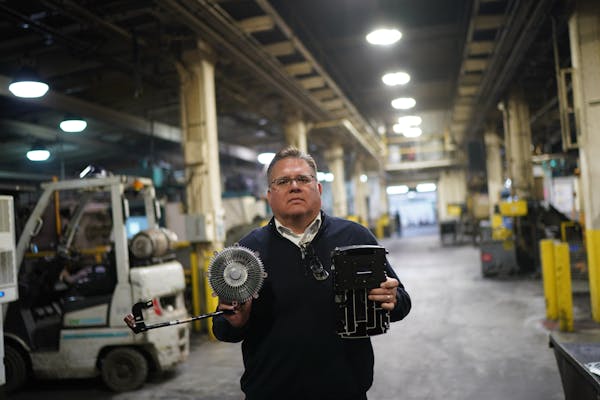The United Auto Workers union expanded its strike from three to 38 locations across 20 states, officials announced Friday, including a couple of sites in the Twin Cities metro area.
The strike expansion, which means another 5,600 auto workers will be on the picket lines, is a significant escalation and worrisome to car dealers, parts suppliers and auto transportation business owners in Minnesota and elsewhere in the nation.
The move comes one week after 13,000 UAW members went on a partial strike, shutting down one factory from each of the Big Three automakers: General Motors, Chrysler owner Stellantis and Ford. Friday afternoon, UAW President Shawn Fain called for the strike to involve additional GM and Stellantis parts distribution locations, including a Stellantis facility in Plymouth and a GM facility in Hudson, Wis.
The UAW did not include more Ford locations, given the union felt it made "real progress" this week during bargaining discussions with the company, Fain said in a statement posted online Friday morning.
The 38 new locations picked Friday "were a surprise," Twin City Die Castings CEO Todd Olsonsaid in an email.
"[The new strike sites] are all part distribution centers and warehouses. Almost all, if not all, of the parts go to dealers who service vehicles," said Olson, who makes metal die castings for the big automakers. "It will impact the dealers and consumers more than the Big Three. It shouldn't really impact their ability to sell cars, but fairly soon, it will impact the ability to repair them."
It's already being felt at Luther Hudson Chevrolet GMC.
"The [GMC] parts warehouse is in Hudson, here, [the workers] all walked out," service representative Jack Johnson said. "So all the dealers won't be getting parts for a while until they figure this out."
The UAW's move to target parts distribution centers rather than more production plants means the strike will affect more consumers using dealers for repairs, should parts be in short supply.
Some other GMC and Chrysler parts distributors across the Twin Cities could not be reached for comment.
In a Facebook post, Fain accused two of the big automakers of wasting time by not working quickly enough to address union demands made two months ago.
"We've made real progress at Ford. We're not there yet. But I want you to see the direction that Ford is going and what we think that means for our contract fight," he wrote.
Ford has eliminated a two-tier wage system at its Rawsonville Components and Sterling Axle locations — both in Michigan — meaning those workers "will now be on the same wage scale as assembly workers," Fain said. In addition, Ford also reinstated a long-suspended cost of living adjustment, converted its temporary workers to full status with profit sharing and provided select job security protections for workers in the event of layoffs.
"To be clear: We are not done at Ford. We still have serious issues to work through. But we do want to recognize that Ford is serious about reaching a deal," Fain said. "At GM and Stellantis, it's a different story."
UAW officials lamented how GM and Stellantis have not provided sufficient cost-of-living adjustments to worker wages and are still rejecting the union's profit-sharing proposals.
Automakers have complained in public about the need to invest profits into electric vehicles and maintained their officials are not greedy. They also have noted UAW workers make more than $80,000 a year, and that's without factoring in benefits and overtime.
Last week, officials from the Minnesota Auto Dealers Association, Walser Automotive, Fury Motors and Twin City Die Castings said Minnesota's economy wouldn't be immune to the strike, but the severity of new car shortages, parts shortages and financial disruptions would vary depending on how long and how widespread the strike becomes.
Until noon Friday, UAW autoworkers seeking higher wages and better retirement benefits were only striking at assembly lines at the GM plant in Wentzville, Mo., the Ford Ranger truck and Bronco SUV plant in Wayne, Mich. and the Stellantis complex in Toledo, Ohio.
It will likely take weeks before the strike causes any noticeable shortage of new vehicles, analysts told the Associated Press. But prices could rise sooner than projected if the chance of a long strike triggers panic buying.
The strike currently involves 10% of the UAW's 146,000 members, meaning the union's $825 million strike fund could last for a while, especially with most members still working and paying into the fund so those on strike can receive $500 a week.
President Joe Biden will lend his support Tuesday when he travels to Michigan to join the picket line.
"[I] stand in solidarity with the men and women of UAW as they fight for a fair share of the value they helped create," Biden wrote in announcing his plans. "It's time for a win-win agreement that keeps American auto manufacturing thriving with well-paid UAW jobs."
Analysts at Deutsche Bank estimated Friday to the AP that GM, Ford and Stellantis have lost production of more than 16,000 vehicles so far due to the strike. Michigan consulting firm Anderson Economic Group estimated the automakers had lost more than $1.6 billion.
The Associated Press contributed to this report.
